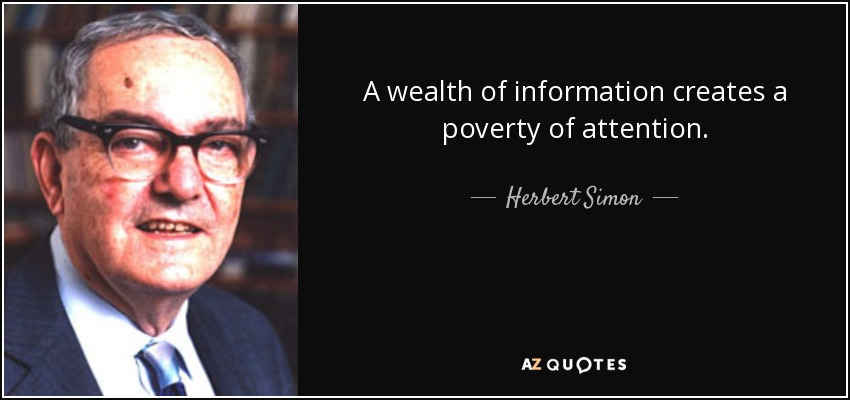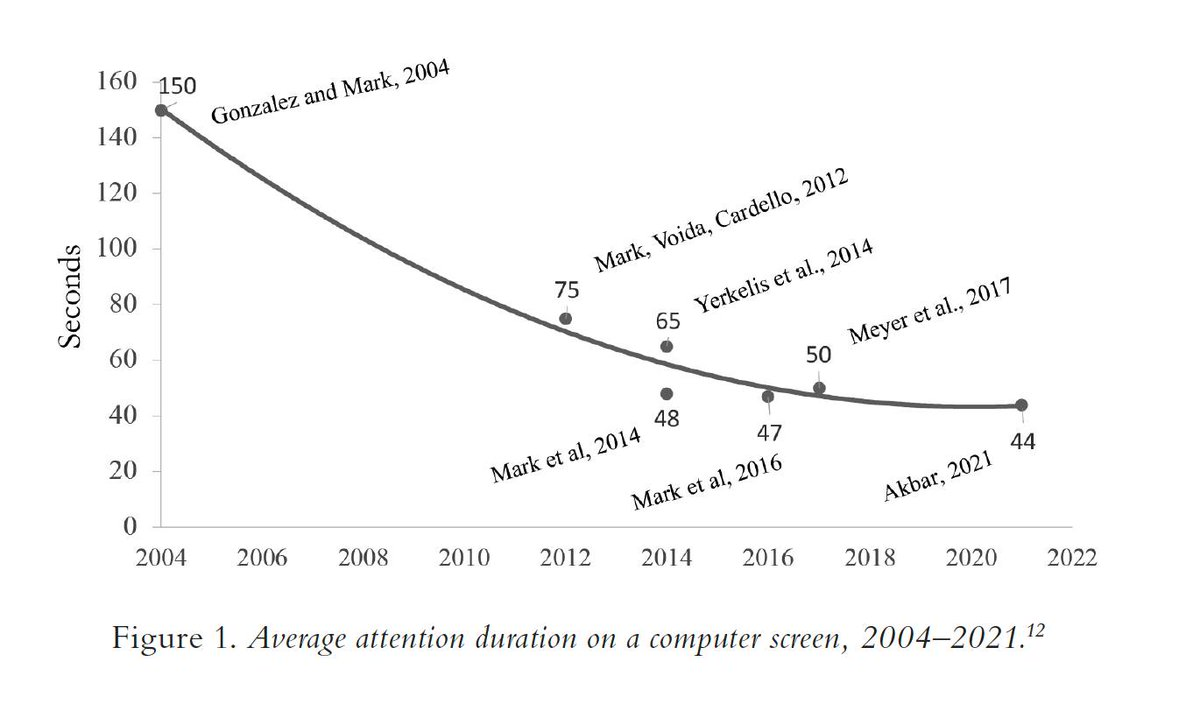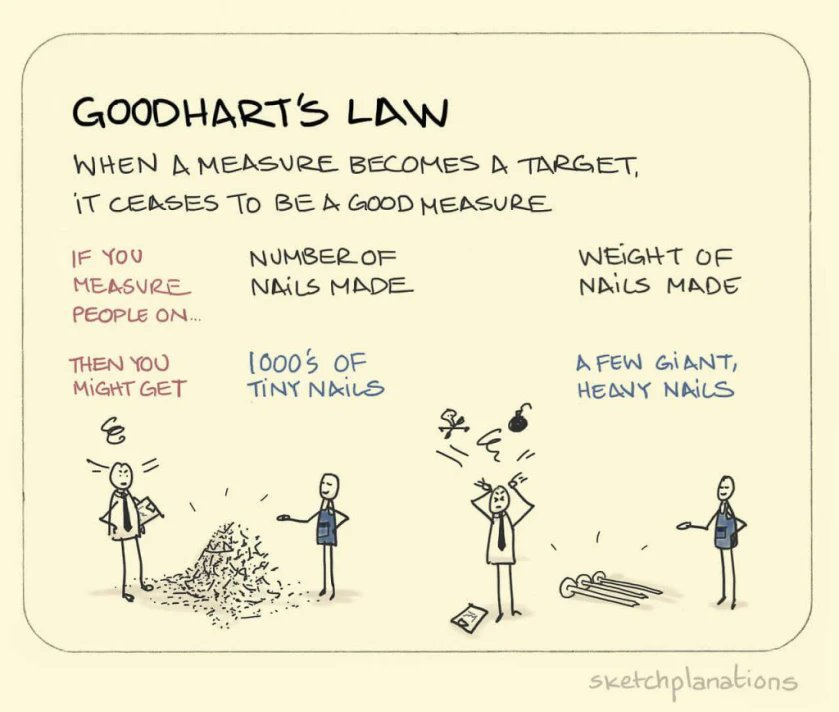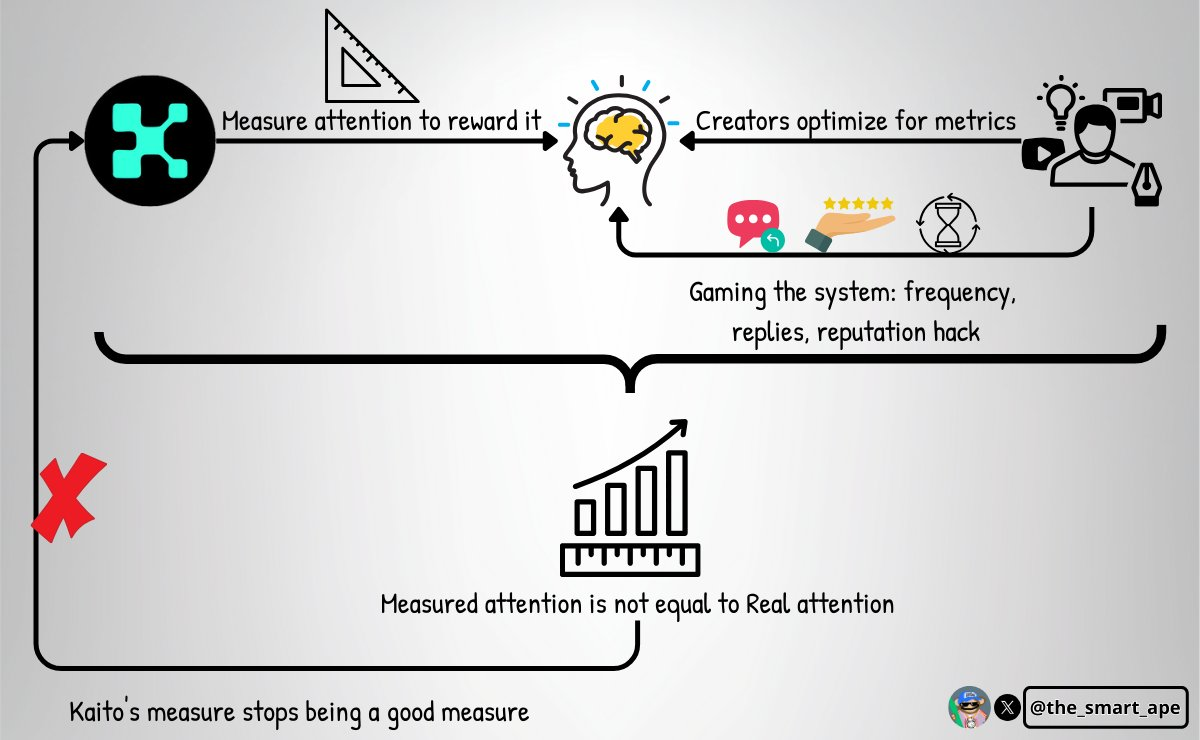Sự chú ý đang dần đánh mất ý nghĩa vốn có của nó
Gần đây tôi bắt gặp một câu nói của Herbert Simon: “Sự dư thừa thông tin sẽ dẫn đến sự nghèo nàn về sự chú ý.”

Câu nói này đã xuất hiện từ năm 1971 và theo thời gian, giá trị của nó ngày càng được khẳng định rõ nét hơn.
Với cách tiếp cận từ @ KaitoAI, sự chú ý đã được biến thành một loại “tiền tệ”, nơi giá trị của nội dung được định lượng và quy đổi thành Yaps – phần chia sẻ tâm trí trên thị trường.
Tuy nhiên, ẩn sau lời hứa này là một nghịch lý: khi chúng ta tìm cách tập trung và thương mại hóa sự chú ý, chúng ta lại có nguy cơ làm kiệt quệ nguồn tài nguyên này. Sự chú ý đang tự hủy hoại chính nó.
1/ Bối cảnh
Nghiên cứu gần đây cho thấy thời lượng tập trung trung bình trước màn hình hiện đã giảm xuống còn khoảng 50 giây, so với 2 phút ở đầu thập niên 2000.

Mỗi lần bị gián đoạn sẽ cần khoảng 23 phút để khôi phục lại trạng thái tập trung sâu.
Số liệu này chứng minh rằng càng tăng lượng thông tin và tín hiệu để cạnh tranh sự chú ý, chúng ta càng khiến sự chú ý bị mai một.
Trong tâm lý học, hiện tượng này được gọi là “Directed Attention Fatigue (DAF)” – trạng thái mệt mỏi khi não bộ liên tục phải sàng lọc các tác nhân gây xao nhãng để duy trì sự tập trung.
2/ Tâm lý học về sự chú ý
Chủ đề sự chú ý gắn liền với nhiều nghiên cứu tâm lý và nghịch lý thú vị.
Charles Goodhart từng khẳng định: “Khi một thước đo trở thành mục tiêu, nó sẽ không còn là thước đo tốt.”

Kaito đặt mục tiêu đo lường sự chú ý để trao thưởng. Tuy nhiên, khi sự chú ý trở thành đích nhắm, các phép đo của Kaito mất đi giá trị thực.

Nhiều nghiên cứu khác cũng chỉ ra rằng khi phần thưởng thay thế động lực nội tại, tính sáng tạo và sự gắn kết chân thành đều giảm sút. Tại Kaito, chính phần thưởng đã làm giảm đi tính chân thực của nền tảng.
Điểm đặc biệt là hệ thống thưởng của Kaito rất dễ gây nghiện, tương tự các trò chơi casino.
Nó giữ chân nhà sáng tạo, nhưng kéo theo đó là hệ lụy mệt mỏi và phụ thuộc, khiến cho sự chú ý chung bị suy yếu.
3/ Lời hứa của Kaito
Chẳng lạ gì khi Kaito tạo ra sức hút mãnh liệt cho người sáng tạo, bởi nền tảng này phân bổ phần thưởng lớn theo trải nghiệm gam hóa. Tổng cộng, Kaito đã phân phối hơn 110 triệu USD (không tính các airdrop nội bộ) cho hơn 200.000 ví.

Một số chiến dịch cá nhân giúp nhà sáng tạo thu về hơn 200.000 USD.
Thế nhưng chính quy mô khuyến thưởng này lại là nguyên nhân bào mòn sự chú ý. Khi có quá nhiều tiền và phần thưởng, nhà sáng tạo bị thúc ép tối ưu hóa tần suất đăng bài, chiến lược phản hồi và các chiêu thức tương tác, thay vì tập trung vào chiều sâu nội dung.
Thêm nữa, thực tế là bài đăng trên X chỉ duy trì vòng đời khoảng 80 phút, sau đó lượng tương tác sẽ tụt dốc mạnh. Điều này khiến nhà sáng tạo chịu áp lực phải đăng liên tục. Một số người công khai đến hơn 200 bài mỗi tháng chỉ về một dự án để “canh tác” phần chia sẻ tâm trí.
Kết quả là độc giả bị bội thực bởi nội dung trùng lặp, càng ngày càng chai lì và mất hứng thú, dù nội dung có thể hữu ích.
Nhiều người tôi biết đã chủ động tắt tên dự án trên bảng tin suốt các chiến dịch Kaito chỉ để tránh bị làm phiền.

4/ Sự chú ý bị bào mòn
Bảng xếp hạng của Kaito cũng không giúp ích, chính tôi đã từng trải nghiệm điều này.
Khi bạn đứng đầu, bạn luôn cảm thấy phải duy trì vị trí ấy, nên bản thân phải liên tục chạy theo nhịp độ mệt mỏi để giữ thứ hạng. Tâm lý là bạn đã hình dung ra phần thưởng mình sẽ nhận được.

Cảm giác đúng như đang ở casino. Bạn không biết được chính xác mình sẽ nhận về bao nhiêu. Có lúc hệ thống rất hào phóng, có lúc lại gây thất vọng, nhưng luôn cuốn hút khiến người chơi khó dứt.
Nó đem lại nhiều niềm vui cho cộng đồng CTs, nhưng cũng không ít thất vọng và mệt mỏi. Một điều chắc chắn: hầu như ai cũng tham gia rất nghiêm túc. Tôi cũng không ngoại lệ!
Điều này thúc đẩy tất cả chúng tôi xây dựng chiến lược chơi, mạng lưới hỗ trợ, tối ưu hóa tương tác... Đích đến không còn là sự chú ý thực, mà là màn trình diễn sự chú ý để giành phần thắng.
Bản thân tôi vẫn chơi nên tôi cũng là thành phần của trò chơi này 😉
Nhưng cá nhân tôi hiểu, cái giá phải trả là dòng nội dung trở nên nhàm chán, đồng phục, làm mất đi sự độc đáo thực thụ.
5/ Kaito nhận thức rõ
Kaito hoàn toàn ý thức được thực trạng này, minh chứng là các bản cập nhật gần đây.
Tôi nghĩ họ vẫn có thể làm tốt hơn để giảm hiệu ứng “bào mòn sự chú ý” (trong trường hợp chưa triển khai):
- tính tới thời gian đọc thực tế,
- thưởng cho tính độc đáo về nội dung,
- khuyến khích đa dạng hóa nguồn tham khảo,
- xử phạt spam bằng cách giãn cách thời gian đăng.
Tôi không rõ họ đã thực hiện chưa, nhưng cũng nên xem trọng những nội dung giữ được sự chú ý chuyên sâu (2–5 phút đọc).
Nền tảng có thể tăng thưởng cho các bài viết dài, tổng hợp, không chỉ là các đoạn nội dung viral ngắn.
Vấn đề không nằm ở khâu đo lường, mà là ở việc duy trì sự chú ý dài hạn – điều này rất khó, thậm chí bất khả thi.
Kết luận
Hiện nay, Kaito và xu thế thương mại hóa sự chú ý đang ở đỉnh cao.
Nhưng những dấu hiệu mệt mỏi đã xuất hiện rõ rệt. Không có gì vĩnh viễn trong hệ sinh thái này; chắc chắn xu hướng này sẽ đến lúc mờ nhạt. Giống như sự chú ý, chỉ là nhất thời.
Bài toán lớn nhất của Kaito là kéo dài sự sống của nó càng lâu càng tốt, và họ đang nỗ lực thực hiện thông qua các bản cập nhật và phát triển sản phẩm.
Nhưng giống như nhiên liệu hóa thạch, chúng ta đã khai thác thương mại hóa một nguồn lực hiếm, và đang đối mặt với nguy cơ tiêu thụ nhanh hơn khả năng tái tạo.
Để làm rõ, tôi cũng tham gia trò chơi chú ý trên Kaito. Dù chỉ lựa chọn một số dự án hợp gu và có kỳ vọng tích cực, trò chơi đó vẫn có ý nghĩa với tôi.
Tôi luôn theo dõi thứ hạng, kiểm tra Yaps mỗi ngày, đo lường ảnh hưởng các bài viết đến phần chia sẻ tâm trí, v.v... nên hoàn toàn có đủ trải nghiệm để nhận định về chủ đề này.
Đây thực sự là một trò chơi đòi hỏi tâm lý và nhiều phần thưởng cho người sáng tạo. Nhưng cuối cùng, tôi vẫn luôn cố gắng giữ mình tỉnh táo, bất kể kết quả ra sao trên Kaito, và nhắc nhở rằng giá trị thật sự là tiếp tục tạo ra giá trị cho cộng đồng, bất chấp các chỉ số.
Tuyên bố miễn trừ trách nhiệm:
- Bài viết này được đăng lại từ [the_smart_ape]. Mọi quyền tác giả thuộc về tác giả gốc [the_smart_ape]. Nếu bạn có ý kiến về việc đăng lại, vui lòng liên hệ đội ngũ Gate Learn để được giải quyết nhanh chóng.
- Tuyên bố miễn trừ trách nhiệm: Ý kiến, quan điểm trong bài viết này hoàn toàn thuộc về tác giả, không phải tư vấn đầu tư.
- Bản dịch bài viết sang các ngôn ngữ khác do đội ngũ Gate Learn thực hiện. Trừ trường hợp có thông báo khác, nghiêm cấm sao chép, phát tán hoặc đạo văn bản dịch này.
Bài viết liên quan

Tronscan là gì và Bạn có thể sử dụng nó như thế nào vào năm 2025?

Coti là gì? Tất cả những gì bạn cần biết về COTI

Stablecoin là gì?

Mọi thứ bạn cần biết về Blockchain

Thanh khoản Farming là gì?
